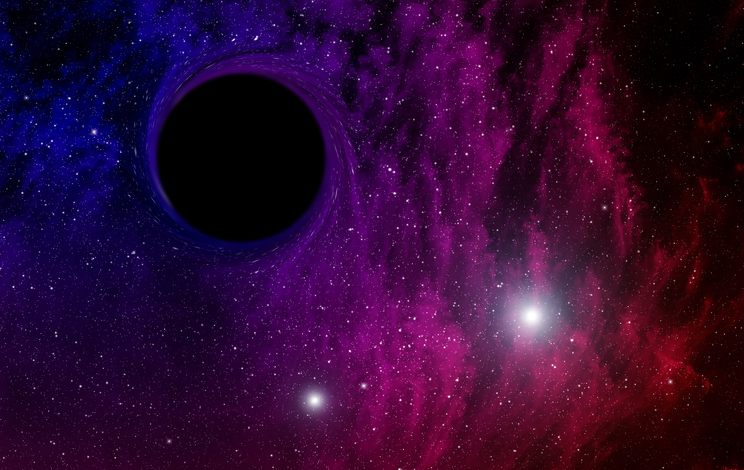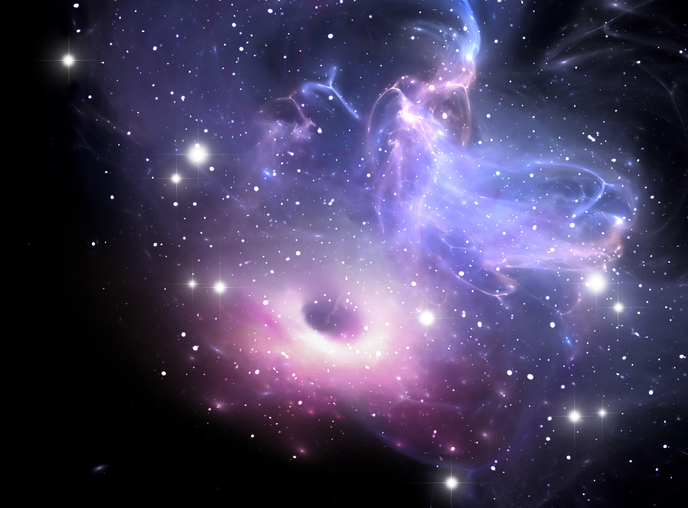X-rays have been detected from behind a black hole for the first time ever
As predicted by Einstein.

- Researchers at Stanford University have noticed some odd X-ray behavior from black holes
- The phenomenon was predicted by Einstein over 100 years ago
- More work is needed to fully understand the process
Researchers at Stanford University have found an odd pattern while observing the X-rays from the supermassive black hole at the center of a galaxy 800 million light-years away. The black hole, it appears, is spewing out these rays into the universe around it.
Dan Wilkins, who made the observations, saw a number of thrilling, but not unusual, bright X-ray flares. Then, the telescopes caught a surprise: more X-ray flashes that were smaller, later, and had different “colors” than the bright flares.
Such a phenomenon has been theorized to exist before and is explained by the fact that as gas descends into a supermassive black hole, brilliant flares of X-ray emissions are produced — exactly as seen by researchers.

Short X-ray flashes were then observed after the flares subsided. These flashes corresponded to the reflection of the flares from the far edge of the disc, which had been curved around the black hole by its potent gravitational field. The flares then reverberated off of the gas plunging towards the black hole.
Although even a rudimentary understanding of black holes reveals that this is a weird place for light to originate from, the theory suggests that these bright echoes are compatible with X-rays reflected from behind the black hole.
“Any light that goes into that black hole doesn’t come out, so we shouldn’t be able to see anything that’s behind the black hole,” explained Wilkins, who is a research scientist at the Kavli Institute for Particle Astrophysics and Cosmology at Stanford and SLAC National Accelerator Laboratory.”
“It is another strange characteristic of the black hole, however, that makes this observation possible. “The reason we can see that is because that black hole is warping space, bending light and twisting magnetic fields around itself,” Wilkins added.
The odd discovery was described in a study that appeared on July 28, 2022, in Nature (linked below). It is the first direct observation of light coming directly from behind a black hole, a scenario that Einstein’s theory of general relativity predicted but which had never been verified before.

“Fifty years ago, when astrophysicists starting speculating about how the magnetic field might behave close to a black hole, they had no idea that one day we might have the techniques to observe this directly and see Einstein’s general theory of relativity in action,” said Roger Blandford, a co-author of the paper who is the Luke Blossom Professor in the School of Humanities and Sciences, Stanford Professor of physics, and SLAC Professor of particle physics and astrophysics.
The study was originally to study black hole coronae
This study’s initial goal was to better understand the corona, a puzzling characteristic of some black holes. The universe’s brightest constant sources of light are powered by material falling into supermassive black holes, and as it does so, a corona is created around the black hole. It is possible to map and describe a black hole by analyzing these X-ray photons.
According to the dominant theories, a corona is created when gas enters a black hole and superheats to millions of degrees. A magnetized plasma is produced when electrons split from atoms at that temperature.
The magnetic field becomes completely broken as a result of the black hole’s strong spin, which causes it to arch so high above the black hole and spin erratically that it has been given the term “corona.” This phenomenon is similar to what occurs around our own Sun.
“This magnetic field getting tied up and then snapping close to the black hole heats everything around it and produces these high energy electrons that then go on to produce the X-rays,” explained Wilkins.
Wilkins also noticed a string of smaller flashes as he got closer to the flares to examine their source. The scientists discovered that these are the identical X-ray flares that were reflected from the disk’s back, giving them their first look at a black hole’s far side.
“I’ve been building theoretical predictions of how these echoes appear to us for a few years,” said Wilkins. “I’d already seen them in the theory I’ve been developing, so once I saw them in the telescope observations, I could figure out the connection.”
So, what’s next?
More observations will be needed as the effort to describe and comprehend coronas progresses. Athena, an X-ray observatory built by the European Space Agency, will be a part of that future (Advanced Telescope for High-ENergy Astrophysics). Wilkins is working on the Wide Field Imager detector for Athena in the lab of Steve Allen, a professor of physics at Stanford, as well as particle physics and astrophysics at SLAC.

“It’s got a much bigger mirror than we’ve ever had on an X-ray telescope and it’s going to let us get higher resolution looks in much shorter observation times,” said Wilkins. “So, the picture we are starting to get from the data at the moment is going to become much clearer with these new observatories.”
You can view the entire study for yourself in the journal Nature.
Abstract:
“The innermost regions of accretion disks around black holes are strongly irradiated by X-rays that are emitted from a highly variable, compact corona, in the immediate vicinity of the black hole1,2,3. The X-rays that are seen reflected from the disk4, and the time delays, as variations in the X-ray emission echo or ‘reverberate’ off the disk5,6, provide a view of the environment just outside the event horizon. I Zwicky 1 (I Zw 1) is a nearby narrow-line Seyfert 1 galaxy7,8. Previous studies of the reverberation of X-rays from its accretion disk revealed that the corona is composed of two components: an extended, slowly varying component extending over the surface of the inner accretion disk, and a collimated core, with luminosity fluctuations propagating upwards from its base, which dominates the more rapid variability9,10. Here we report observations of X-ray flares emitted from around the supermassive black hole in I Zw 1. X-ray reflection from the accretion disk is detected through a relativistically broadened iron K line and Compton hump in the X-ray emission spectrum. Analysis of the X-ray flares reveals short flashes of photons consistent with the re-emergence of emission from behind the black hole. The energy shifts of these photons identify their origins from different parts of the disk11,12. These are photons that reverberate off the far side of the disk, and are bent around the black hole and magnified by the strong gravitational field. Observing photons bent around the black hole confirms a key prediction of general relativity.”
 SHOW COMMENT ()
SHOW COMMENT ()









